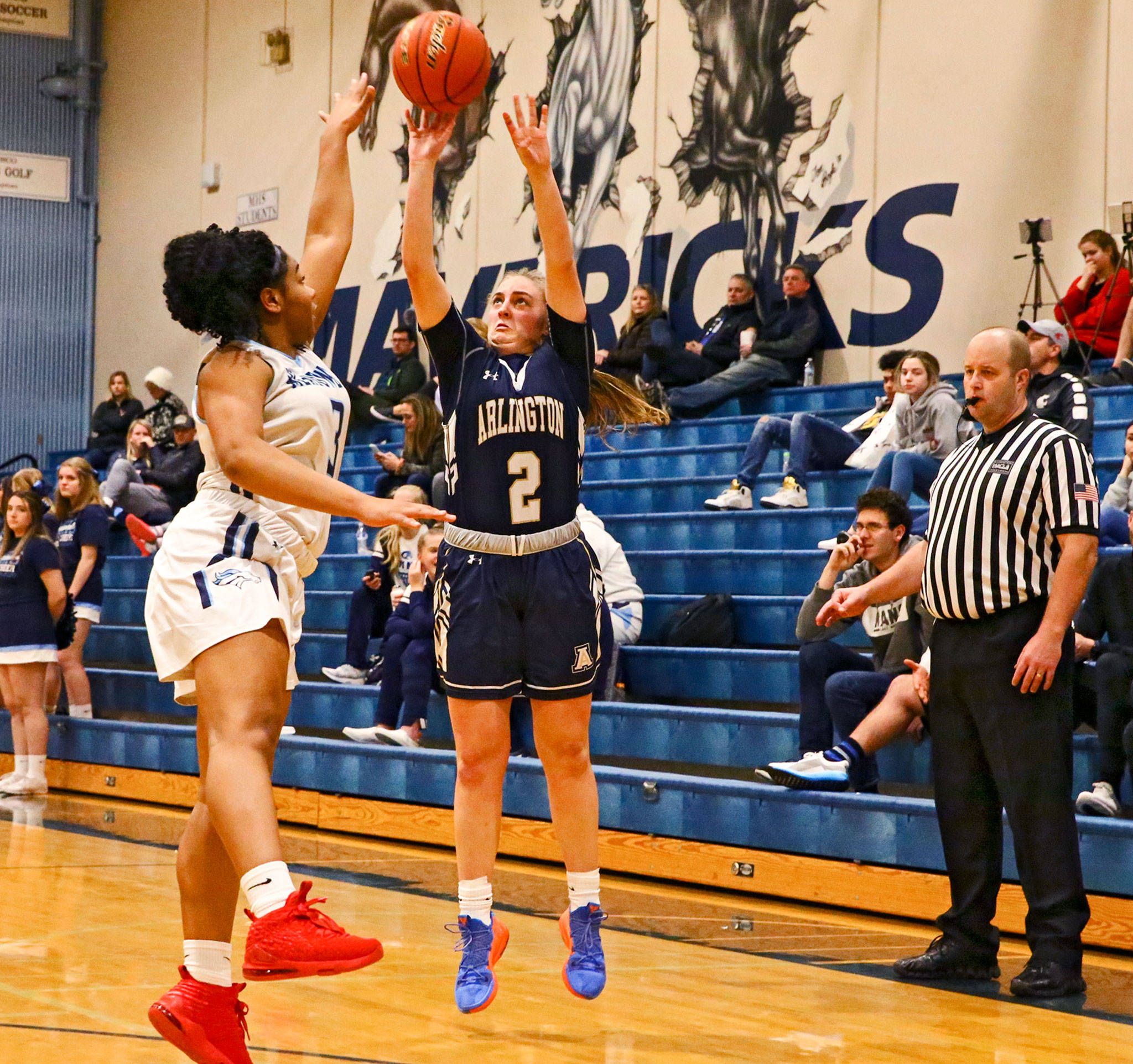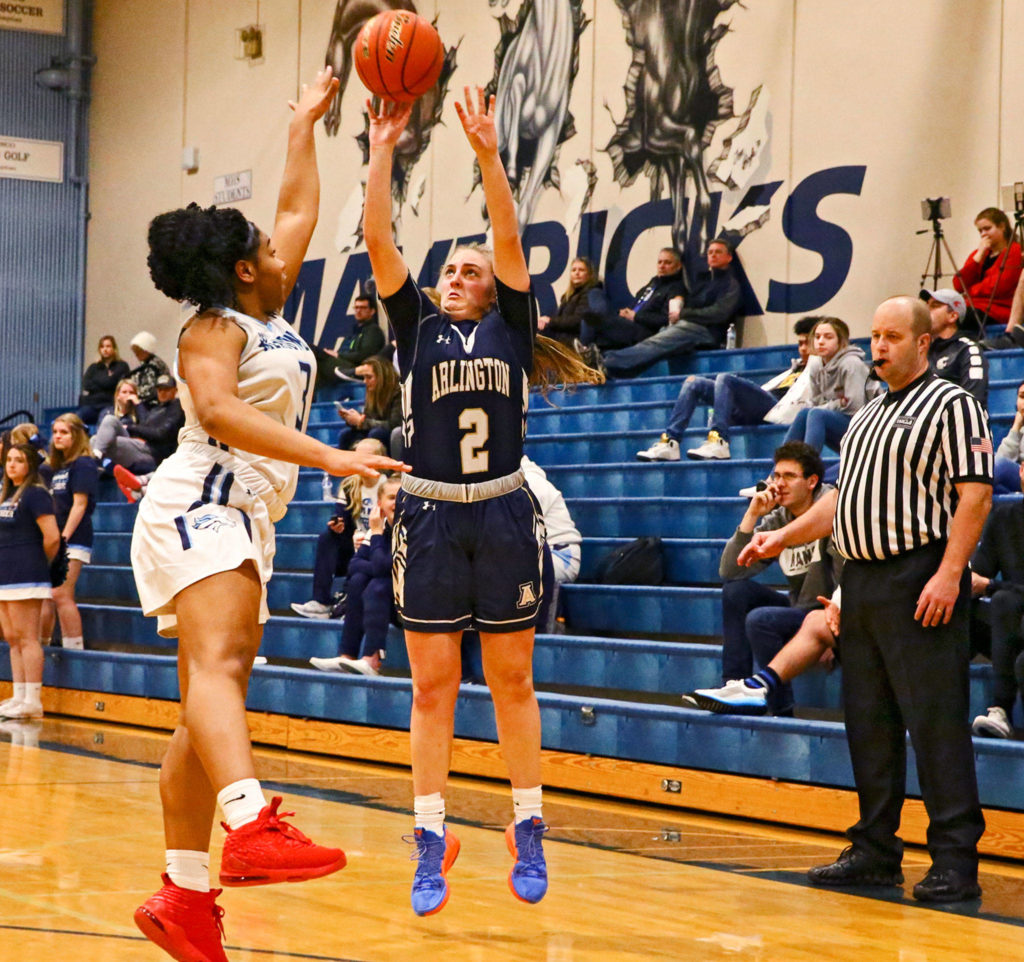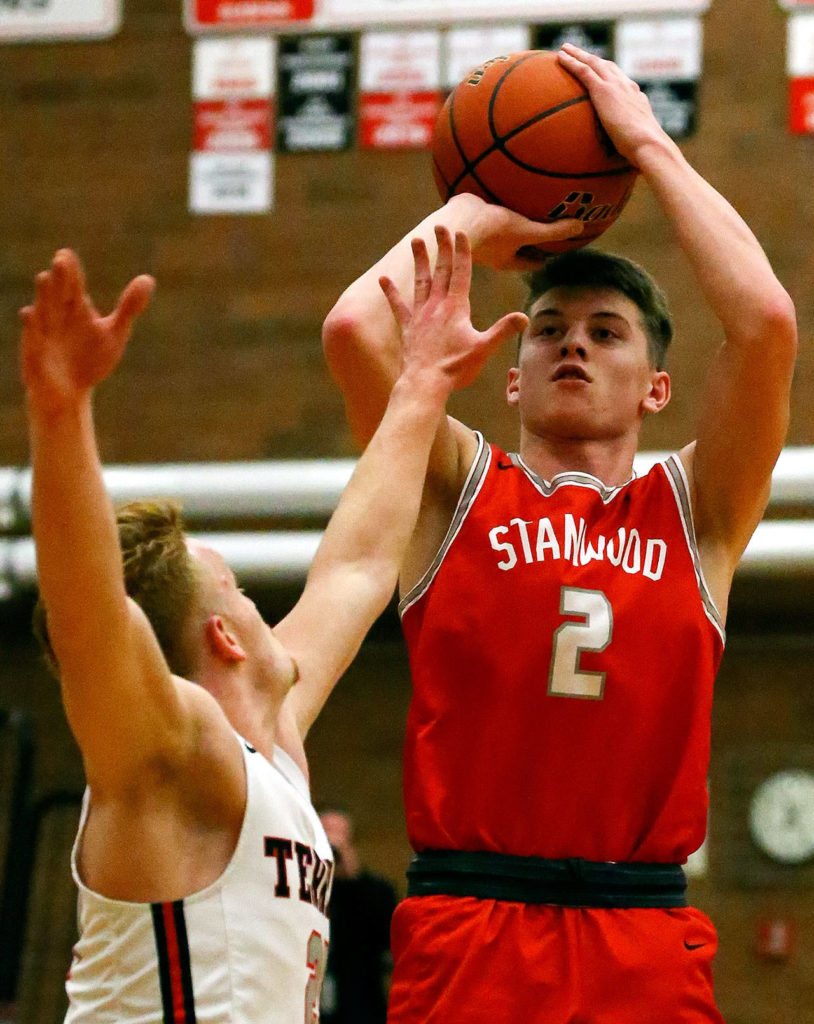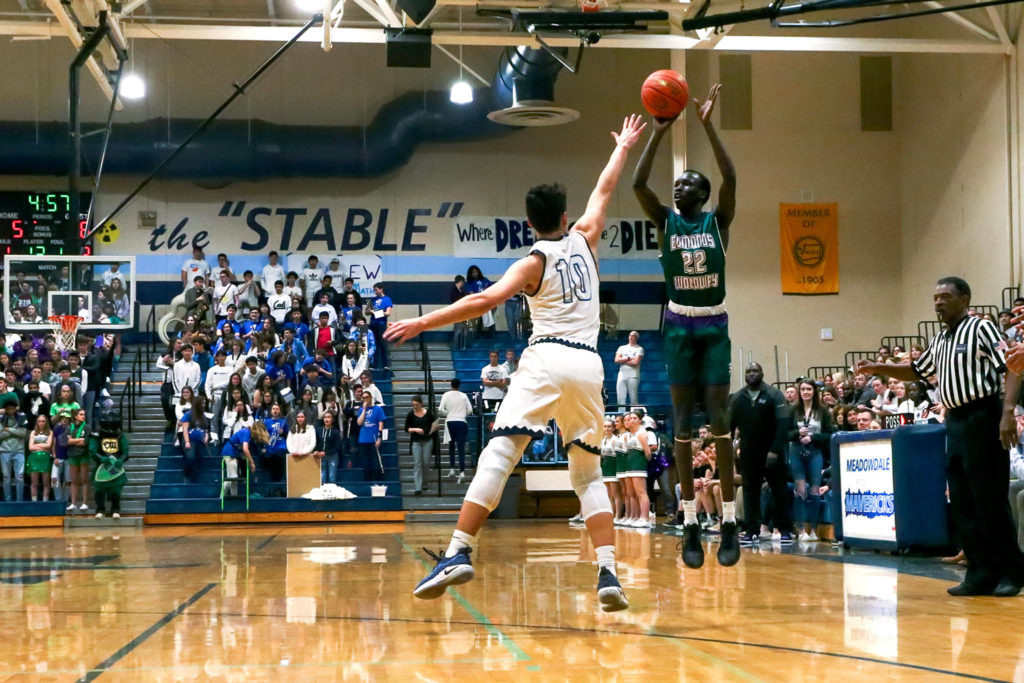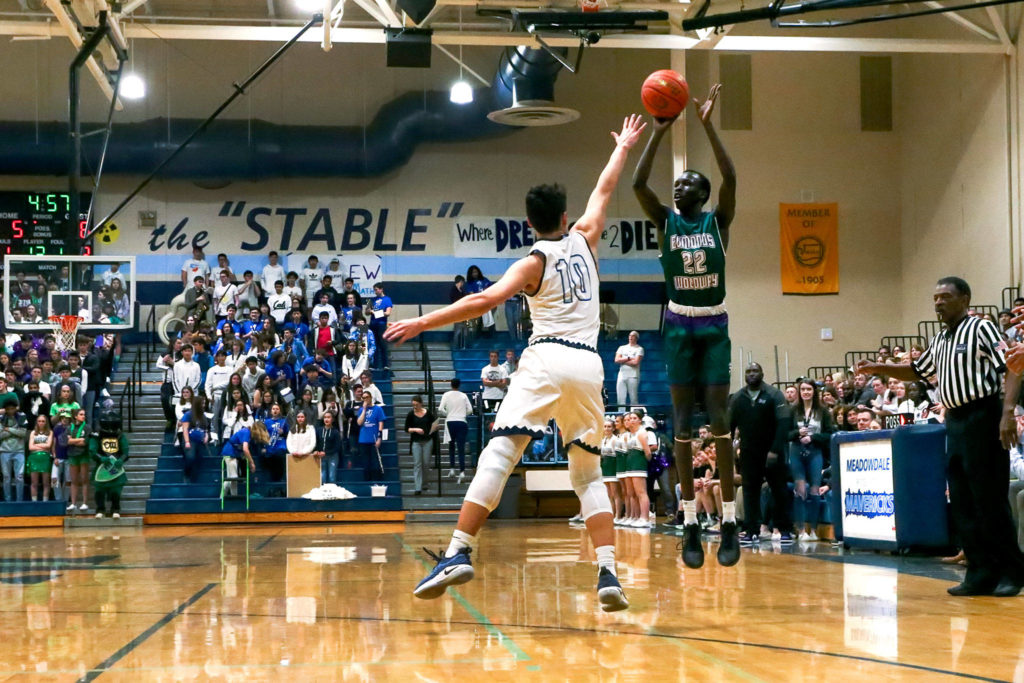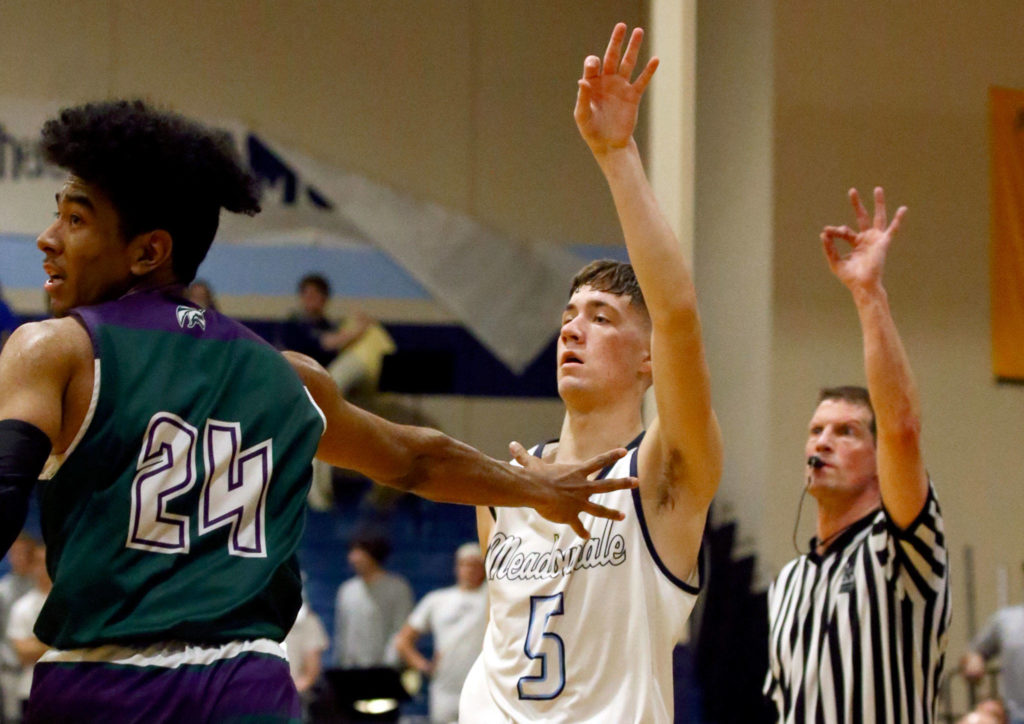ARLINGTON — Last year, the Eagles did something staggering.
On average, the Arlington High School girls basketball team launched a 3-point shot nearly once a minute, as players took a remarkable 28 attempts per game from at least 19 feet and 9 inches away.
The Eagles shot more often from beyond the 3-point arc than within it.
This year, coach Joe Marsh had a message for his team: Shoot even more threes.
“I told the team this year I’d really like to get that closer to 35,” he said.
The Arlington girls are an extreme example, but they’re part of a new trend in high school basketball.
A dozen local boys and girls coaches shared their thoughts with The Daily Herald, and nearly all of them said they’ve noticed a recent climb in 3-point attempts.
“Attempts aren’t up as much as college (or the) NBA, but it’s heading there,” Jackson boys coach Steve Johnson said.
Stats back it up. In a two-week span last month, at least four local players matched or broke school records for 3-pointers.
Hailey Hiatt tied the Arlington girls record with nine in a game.
Mack Konig drained eight to break the Jackson girls mark.
And on back-to-back nights, Raigan Reed made Lake Stevens girls history and Ian Mahler tied the Lake Stevens boys record, hitting eight treys apiece.
“There’s definitely been a rise in the number of 3-point attempts and just the number of guys on each team that have the ability to stretch the floor and change a game plan,” longtime Lake Stevens boys coach Mark Hein said. “Multiple teams in our league have several guys that you really can’t leave unguarded at the 3-point line. It’s just really changed the game defensively and offensively.”
That’s not to say every high school team has changed its offensive philosophy. Strategy varies from team to team, or even year to year within a program.
“Sometimes you have kids that shoot the 3-pointer well, and sometimes you don’t,” Hein said.
In Arlington, the green light is always on.
The Eagles haven’t quite reached their goal of 35 attempts per game, but they’re now at exactly one per minute in the 32-minute high school game.
And it’s working. At 17-2, they’ve excelled with a fast-paced and high-volume shooting attack. Their 64.9 points per game are the high watermark in Wesco 3A/2A.
“We have shooters,” Marsh said. “So we feel like it’s an advantage for us, the more (3-point) shots we get up.”
The numbers game
The 3-point line has been part of basketball for decades.
The NBA adopted 3-pointers in 1979. The NCAA followed in 1986, and it was implemented nationwide for high school in 1987.
But in recent years, the upper levels of basketball have seen a long-distance surge.
The Golden State Warriors, led by the “Splash Brothers” duo of Stephen Curry and Klay Thompson, revolutionized a new style of play, with record-setting 3-point shooting during their recent run of three NBA championships in four years.
The NBA 3-point attempt rate has increased dramatically, skyrocketing from 22.6% of all field-goal attempts in the 2011-12 season to 35.9% in 2018-19, according to Forbes.
College basketball also has seen a spike, so much that the NCAA moved the Division I men’s 3-point line back nearly 17 inches this season, to 22 feet 1¾ inches.
“I really think (the Warriors) had a trickle-down effect to high school basketball,” Hein said.
Golden State’s immense success brought analytics and the expected value of certain shots — the shooting percentage of a particular shot, multiplied by how many points a shot is worth — to the attention of fans.
It’s part of the sabermetric wave of the “Moneyball” era that has changed how people look at sports.
According to NBA data from FiveThirtyEight over a recent five-season span, the expected value of most 2-point jump shots is less than 0.85 points.
Meanwhile, a 3-point shot’s expected value is typically between 1.05 and 1.1 points.
Shots within several feet of the basket generally have an expected value above 1.2 points.
“Everyone just understands the math a little bit better than really anyone did 15 or 20 years ago,” said Meadowdale boys coach Roger O’Neill, a former hoops star at the school who graduated in 2009. “ … (The 3-point rise in high school) was already starting to happen a little bit, but obviously the Warriors’ success just put that right in everyone’s face for everyone to see.”
The analytics movement has led some high school teams to prioritize 3-pointers and layups over mid-range shots.
“A lot of people are analytics disciples, so they know the value of layups and the value of threes,” Lake Stevens girls coach Randy Edens said. “It’s definitely changed some of the way people look at offense in terms of what type of shots you’re trying to get.”
However, the numbers only favor taking increased 3-point attempts if a team has shooters good enough to make them at a baseline rate. High-schoolers are generally less accurate than NBA shooters, so the numbers don’t translate perfectly.
“If you’re a bad 3-point shooter,” O’Neill said, “taking that shot is basically a turnover.”
Positionless basketball
Coaches disagree on whether players are actually any better at shooting 3-pointers, compared to a decade or two ago. But in today’s era of versatile post players and positionless basketball, it’s clear more players are attempting such shots.
In the past, the tallest players were typically confined to the paint — the rectangle within the free-throw line.
Nowadays, many such players step outside and shoot from the perimeter.
“Ten years ago, you didn’t see a post player out there,” Edmonds-Woodway girls coach Jon Rasmussen said. “And now, you’ll see multiple players.”
Anthony Wiederkehr was a Lakewood boys hoops standout who graduated in 2006. He now coaches the team, and said the game has changed drastically since he played.
Conventional two-post offenses have grown rare, with teams instead featuring four players, or even five, who are capable of operating from the perimeter.
“Traditionally, the ‘four’ (position) is a post,” Wiederkehr said. “Nowadays, the majority of the teams that we play, the ‘four’ is a guy that can shoot from three and can handle the ball and do a lot of other things.”
Everybody can play everywhere now, he said.
That means offenses have less structure and more free-flowing attacks, such as the dribble-drive motion offense that has become prevalent over the past decade.
“The style of offense is changing quite a bit,” Wiederkehr said. “A lot of teams just spread it out, drive to the hoop and kick out for open shots.”
Adding a shot clock to the boys game has also increased 3-point shooting. No longer can teams spend unlimited time searching for a high-percentage shot near the basket.
Girls high school basketball in Washington state has had a shot clock since the 1970s, but it wasn’t a part of the boys’ game until 2009.
“Before the shot clock, there was no excuse for taking a bad shot,” said O’Neill, who graduated from Meadowdale just prior to the shot-clock era. “With the shot clock, I think players have more freedom from coaches to showcase their skills, because the opportunity cost of taking that (bad) shot isn’t as severe.”
Defensive answers
As more teams roll out lineups with four or five capable outside shooters, defenders have to cover more space, and often that leaves them in a catch-22.
If they extend to guard the 3-point shot, they’re more vulnerable to offenses attacking the basket.
If they don’t extend, opponents are left open to bury 3-pointers.
“Anyone can shoot it now, and so you’re having to guard all five positions at the 3-point line, where in the past traditionally you only really had to guard maybe two or three players at the 3-point line,” Jackson girls coach Corey Gibb said. “Your bigs are having to go all the way out.”
A pair of jaw-dropping performances in the 2017-18 season showed just how proficient some 3-point shooters can be.
Kamiak’s Carson Tuttle drilled a whopping 13 shots from beyond the arc in one game, and Stanwood’s Karl DeBoer sank 10.
Last month, the Lake Stevens girls held a talented Inglemoor team to just five 2-point buckets — and yet still lost by 11 points. That’s largely because Inglemoor went 12-of-25 from beyond the arc.
“When you have teams that make that high of a number,” Edens said, “I would rather give up layups.”
Some coaches said they’ve adjusted their defensive strategy.
“We always used to try to defend inside out — we’d try to give up the outside shot versus the inside shot,” Arlington boys coach Nick Brown said. “And we’ve kind of changed our thoughts on that.”
In traditional man-to-man defense, when an opponent drives to the basket, the defender one pass away is expected to help the on-ball defender. But that’s changing.
“We don’t help one pass away if you have a shooter in a corner,” Marsh said. “We just make sure we guard the 3-point line.”
According to multiple boys coaches, some high school zone defenses have morphed into the version run by University of Washington men’s coach Mike Hopkins. In an effort to better defend the 3-point shot, the wings on the bottom half of the zone play a bit farther up and out toward the perimeter.
“Hopkins really is concerned about keeping his defense spread to guard the 3-point line, even at the expense of giving up some of those high-post looks,” Hein said. “I feel like some (high school) coaches care less about giving that shot up than they do the 3-point shot.”
The tradeoff
A casualty of basketball’s long-distance trend has been the mid-range jumper.
The frequency of mid-range shots in the NBA has dropped from about 30% to 15% over the past eight seasons, according to Forbes. High school coaches are seeing a similar phenomenon.
“It’s a big gap in our game today,” Brown said.
The value of the mid-range shot is perhaps the biggest debate in basketball analytics. Some coaches, like Arlington’s Marsh, place their emphasis on 3-pointers and layups.
“I have two kids on my team that shoot mid-range jumpers,” Marsh said. “Everybody else, we tell them to shoot threes, because (of the) percentages and all the analytics stuff. We really are kind of a three-or-layup team. And a lot of kids I don’t think work on their mid-range game anymore … so (threes) are what they’re more skilled at.”
Other coaches, however, believe the mid-range shot is still an important part of the game — especially since some defenses are more willing to give up that shot than a 3-pointer.
“I believe that if a kid can really hit a mid-range shot consistently, there’s still a lot of value in it,” Hein said. “In particular, you take a kid like Ian (Mahler), pretty much everyone we play is going to run him off the 3-point line. I still want him to get shots, and some of those shots are a (pump) fake, one-dribble pull-up inside the 3-point line. It’s another way for a skilled player to score the ball.”
There are many ways to win games, and the 3-point shot isn’t the only way to score.
“I see the well coached teams and teams that have the right balance of talent still playing the inside game, still playing the mid-range game, still playing the perimeter game,” Mountlake Terrace boys coach Nalin Sood said.
“At the high school level, you’ve still got to go with what fits for you,” he added. “One size doesn’t fit all. … You’ve got to coach to the cards you’re dealt. And if the cards you’re dealt don’t have a lot of 3-point shooters on it, (high-volume 3-point shooting) is not the right philosophy to prescribe to.”
Coaches said there are also a lot of players who probably shoot threes too often.
“With some of the percentages that some high school kids shoot from three, my opinion would be they’d be better off shooting twos,” Stanwood boys coach Zach Ward said. “We have a lot more kids shooting (threes), but there’s some percentages out there that aren’t great.”
But with the right talent, threes can change the game.
“There’s no more valuable skill to have,” O’Neill said, “than to be a shooter.”
HOW OFTEN LOCAL TEAMS ATTEMPT 3-POINTERS
Percentage of total field-goal attempts from 3-point range:
Arlington girls 54.7%
Edmonds-Woodway girls 46.3%
Lynnwood girls 39.0%
Lake Stevens girls 31.0%
Cedarcrest girls 30.0%
Monroe girls 24.5%
Kamiak girls 23.8%
—
Arlington boys: 44.4%
Marysville Pilchuck boys: 39.5%
Marysville Getchell boys: 37.2%
Stanwood boys: 36.7%
Lake Stevens boys 35.5%
Jackson boys 35.1%
Meadowdale boys 33.6%
Archbishop Murphy boys 30.5%
Shorewood boys 24.0%
Source: Coaches and, when available, MaxPreps.
Talk to us
> Give us your news tips.
> Send us a letter to the editor.
> More Herald contact information.
